|
What is Osechi-ryori?
Osechi-ryori is the name given to specially-prepared New Yearfs dishes eaten during
the first three days of January.
These various kinds of beautifully-prepared
dishes are set in multi-tiered lacquer boxes.
What is the origin of Osechi-ryori?
In Japan, since ancient times, there had been court events which offered
food to the gods at banquets on Sechinichi (*), the days that mark the turning of the seasons.
The dishes that were served at the court events were called Osechiku, which is the origin of Osechi-ryori.
The events became popular among ordinary people during the Edo Period,
and Osechiku started being considered as special dishes prepared for the New Year, as January 1 was the main Sechinichi of the year.
Later, after World War II, Osechiku was sold as Osechi at department stores, and then it came to be known as Osechi-ryori.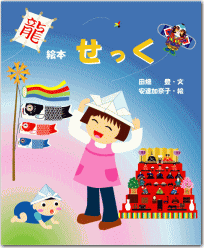
(*)Sechinichi: The days that mark the turning of the seasons on Chinese
almanac. New Year (January 1), and five festival days (January 7, March 3, May
5, July 7, September 9)
Why is Osechi-ryori eaten for three days of the New Year?
It is often said that Osechi-ryori is eaten at the New Year so women can take a rest for at least three days.
However, this practice originally came from
the fact that we were supposed to refrain from cooking in kitchens so as not to
make noise, while welcoming the gods during the New Year.
Therefore, preparation of Osechi-ryori starts at the end of the year by boiling, grilling or soaking in vinegar local and dried foods so that they last longer.
Why is Osechi-ryori set in multi-tiered boxes?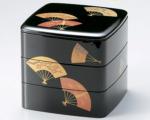
The multi-tiered lacquer boxes symbolize
the hope that happiness comes continuously, like the layers of lacquer ware.
Formal Osechi-ryori is set in five-tiered lacquer boxes. In that case, fifth box is kept
empty as a reserve, indicating the hope that wealth will increase in future.
These days, shorter three-tiered boxes are used most commonly.
What is the meaning of each dish in Osechi-ryori?
Dishes in Osechi-ryori vary greatly depending on the area and family. However, each one is made
to wish for the health and happiness of the family for the coming year.
The names, colors and shapes of the foods often have a superstitious relationship
with the welcoming of good fortune. Examples are as follows: @
Three kinds of necessary festive dishes for the New Year:
EBlack Beans (Kuromame in Japanese): They are associa ted with another meaning of gmame,h to work diligently. These beans express hope for a healthy year of work. ted with another meaning of gmame,h to work diligently. These beans express hope for a healthy year of work.
EHerring Roe (Kazunoko): The literal meaning of the kanji for kazunoko is gmany children.h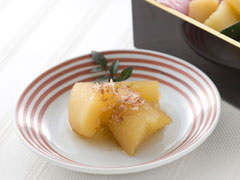 Herring roe represents a wish for many children and the prosperity of
all descendants. Herring roe represents a wish for many children and the prosperity of
all descendants.
ES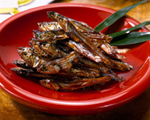 mall, Dried Sardines (Tazukuri): The literal meaning of the kanji for tazukuri is grice paddy maker.h In the past, sardines were scattered as fertilizer
for the rice harvest. They now symbolize hope for a bountiful rice harvest. mall, Dried Sardines (Tazukuri): The literal meaning of the kanji for tazukuri is grice paddy maker.h In the past, sardines were scattered as fertilizer
for the rice harvest. They now symbolize hope for a bountiful rice harvest.
Other assorted delicacies served on the first plate:
ERed and White Boiled Fish Paste (Kohaku Kamaboko): The red and white coloring reflects the festive occasion.
ESweet rolled omelets mixed with fish paste or mashed shrimp (Datemaki): The literal meaning of the kanji for date is brightness, so they are auspicious. And the shape is similar to scrolls.
They symbolize hope for development of culture. 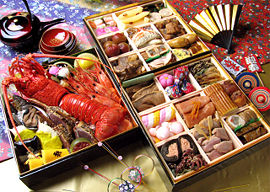
ESweet chestnuts (Kurikinton): The literal meaning of the kanji for kinton is ggolden dumpling.h They symbolize hope for economic fortune.
ECoiled kelp (Kobumaki) : They stand for gyorokobu,hmeaning
happiness. @
Vinegared food:
ERed- and- White-colored Pickles (Kohaku Namasu): Grated giant radish and carrots are also presented in festive colors
of red and white.
Broiled fish:
ESea bream (Tai): This is associated with gmedetai,h meaning happiness or auspiciousness.
EPrawns (Ebi): The shape of bent prawns is associated with elderly people. They symbolize
the hope for longevity.
Cooked dishes:
EAroids (Satoimo) : Aroids grow with a lots of small aroids. They symbolize the hope for fertility.
ELotus roots (Renkon): Lotus roots have holes. They symbolize the hope that we can see the future.
EArrowheads (Kuwai): They have big shoots and symbolize the hope for career success.
EBurdock roots (Gobou) : They root firmly in soil and symbolize the hope for physical strength.
How is modern Osechi-ryori?
Today, thanks to advanced preservation techniques, Western foods, Chinese foods and various other foods, even raw foods can be set in the multi-layered boxes. And while Osechi-ryori has been traditionally prepared at home, the number of people who buy it at grocery stores, department stores and online shops with home delivery service is increasing.@
Reference:@Same as Japanese version.
|
 @@@@@
@@@@@

 ted with another meaning of gmame,h to work diligently. These beans express hope for a healthy year of work.
ted with another meaning of gmame,h to work diligently. These beans express hope for a healthy year of work.  Herring roe represents a wish for many children and the prosperity of
all descendants.
Herring roe represents a wish for many children and the prosperity of
all descendants.  mall, Dried Sardines (Tazukuri)
mall, Dried Sardines (Tazukuri)